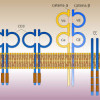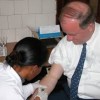Abstract
In February 1992, 22 patients undergoing chronic hemodialysis at an outpatient dialysis center experienced pyrogenic reactions (PR). The PR rate was significantly greater (p < 0.001) during the epidemic (February 3-5) than the pre-epidemic period (November 1, 1992-February 1, 1992). All patients with PR used dialyzers that had been manually reprocessed either on February 1 or 3. These dialyzers contained up to 120.8 EU/ml of endotoxin in the blood compartment. The only dialyzer reprocessed before February 1 that was available for analysis was found to contain no detectable endotoxin, while dialyzers reprocessed during the epidemic period contained a median endotoxin concentration of 52.8 EU/ml. The bioburden of water used to prepare dialysate was in excess of the Association for the Advancement of Medical Instrumentation (AAMI) standard for water, < or = 200 colony forming units (CFU)/ml. Samples of treated water collected in the reuse area were within AAMI standards at the time of the investigation (February 11 and February 26), but before the investigation, water samples were assayed with a culture method that could not detect microbial concentrations below 10(3) CFU/ml. In addition, the treated water feed line to the disinfectant container may never have been disinfected. However, no samples were collected from this line during the investigation. This outbreak emphasizes the need to use water that meets the AAMI bacteriologic and endotoxin standards of < or = to 200 CFU/ml and/or 5 EU/ml, respectively, for reprocessing hemodialyzers nad to ensure that appropriate culture techniques are used for treated water dialysate.
Rudnick JR, Arduino MJ, Bland LA, Cusick L, McAllister SK, Aguero SM, Jarvis WR
Artif Organs 1995 Apr;19(4):289-94
PMID: 7598647… Read more

